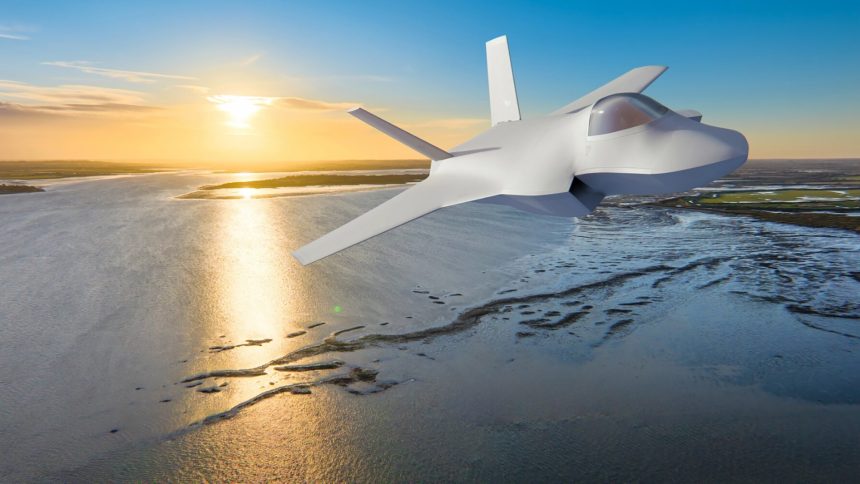A UK developed demonstrator aircraft, which will be used to inform the joint Global Combat Air Programme (GCAP), has been revealed and is expected to be ready to fly by 2027.
The manned aircraft will be the first supersonic design of this kind developed in the UK for four decades. Two thirds of the airframe’s structural weight is said to be in production, including the main fuselage structure, wings, and tail.
Advanced digital manufacturing techniques, including 3D printing, collaborative robotics, and digital twinning, are being used to expedite and simplify the production process. Digital twinning involves the development of an exact digital copy of a design upon which simulated testing can be carried out. This allows for rapid side-by-side comparisons of any modifications, and additionally can allow for testing that would usually be destructive to the physical airframe. These techniques are also being employed for testing involving the Boeing 757 testbed aircraft, known as ‘Excalibur’.
The computer rendering released to depict the demonstrator shows limited detail beyond what we would already expect for a GCAP-related aircraft following the display of models and renderings over the previous few years. One notable aspect, though, is the visibly wide nosecone which could host a large, powerful radar, and potentially additional electronic warfare or surveillance equipment.

With the demonstrator expected to fly by 2027, it is hoped that an operational fighter resulting from GCAP will be operational by 2035. Earlier on Jul. 16, 2025, before this demonstrator was announced, Lieutenant General Antonio Conserva of the Italian Air Force told the Global Air and Space Chiefs’ Conference in London that a flying prototype was due by 2030.
On the second day of the conference, Under-Secretary of State for Defence Luke Pollard noted that GCAP is “progressing well”. He said that “the programme means our nations can come together, not just to defend the Euro-Atlantic, but to support our values on a global stage.”
Keynote Speech at @airpowerassn @RoyalAirForce #GlobalAirSpaceChiefs Conference by Luke Pollard MP, Under-Secretary of State for the Armed Forces. “Europe must step up and take more responsibility for its Defence.” RAF’s return to a dual nuclear capability is a significant step. pic.twitter.com/oPBOZaPKye
— Greg Bagwell (@gregbagwell) July 17, 2025
The minister also emphasized the importance of the interoperation of crewed, uncrewed, and autonomous platforms, something that GCAP is expected to leverage using ‘loyal wingman’ type drones. A new ‘digital targeting web’, which emerged from the UK Strategic Defence Review, would also assist the aircraft in being able to deliver effects against any target at any time.
While it is important to note that this aircraft is not the planned GCAP fighter, and the eventual result of the UK-Italian-Japanese programme will likely end up looking a fair amount different, the demonstrator will help to inform ongoing development and de-risk the actual design. In this case it is similar to the British Aerospace EAP, which was a UK developed demonstrator that helped the development of the multinational Eurofighter Typhoon.
Note Flying Combat Air Demonstrator (better name TBC) is tech prototype informing/de-risking GCAP – and therefore like EAP/Typhoon does not resemble it exactly #avgeek https://t.co/Nkx0IlQS8B pic.twitter.com/rWyLbhCuBL
— Tim Robinson (@RAeSTimR) July 16, 2025
Bespoke simulators have already been configured to emulate the demonstrator aircraft, with pilots from the Royal Air Force as well as BAE Systems and Rolls-Royce having already conducted 300 hours of simulated flying.
Tony Godbold, Future Combat Air Systems Delivery Director at BAE Systems, said “This significant and challenging project will deliver the UK’s first crewed combat demonstrator aircraft in four decades. The programme is accelerating the development of advanced design approaches and manufacturing techniques, helping to sharpen the UK’s industrial edge and deliver benefits beyond the production of the aircraft.”
He further noted that “As well as developing a unique aircraft, we’re building the technical foundations, workforce readiness and digital maturity essential to deliver the next generation of combat air capability.”
Director Future Combat Air for the Ministry of Defence Richard Berthon added: “I am delighted that today, BAE Systems and the Ministry of Defence, can share this important update on the Combat Air Flying Demonstrator. For the first time, people can see how this cutting-edge demonstrator aircraft will look when it takes to the skies. Manufacturing of the aircraft continues at pace, which is testament to the ingenuity and collaboration of Government and industry teams.”
“The Combat Air Flying Demonstrator is providing invaluable lessons on future combat air delivery and equipping our people with the skills they will need to deliver GCAP.”
The UK’s contribution to GCAP is organised under Team Tempest – using the name that formerly referred to the UK’s sovereign sixth generation fighter programme. Primary partners BAE Systems, Rolls-Royce, Leonardo, and MBDA, are joined by other contributors from the industry – including Martin-Baker, GEUK, GKN, Collins Aerospace, Bombardier, QinetiQ, and Thales UK – as well as educational institutions across the UK.
It was an honour to welcome Maria Eagle MP at the official opening of our Edgewing headquarters in Reading, representing another important step in what will be a truly international programme to develop the next generation combat aircraft. Discover more: https://t.co/UzSzo2f7Au pic.twitter.com/3q4uxq79pt
— Edgewing (@EdgewingLtd) July 8, 2025
Following an announcement in December 2023 that the UK will host the headquarters for GCAP, the physical site in Reading, UK, was opened on Jul. 7, 2025. At that time, GCAP was said to be actively supporting over 3,500 jobs in the UK alone. The joint venture company established to unite the three main partners in the programme was unveiled in late June as ‘Edgewing’. The UK, Italy, and Japan each hold a 33.3% stake in the business.









